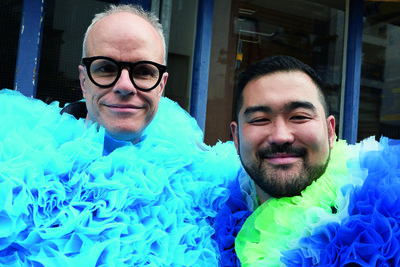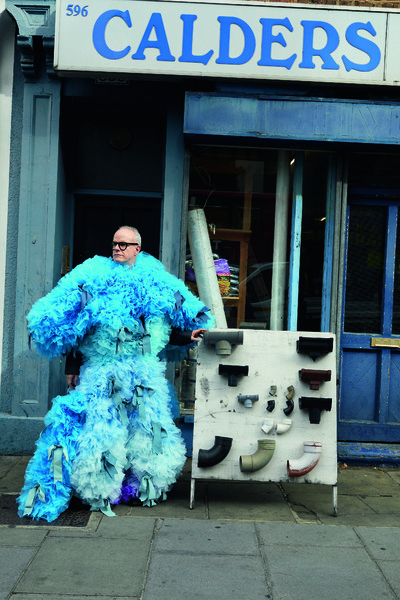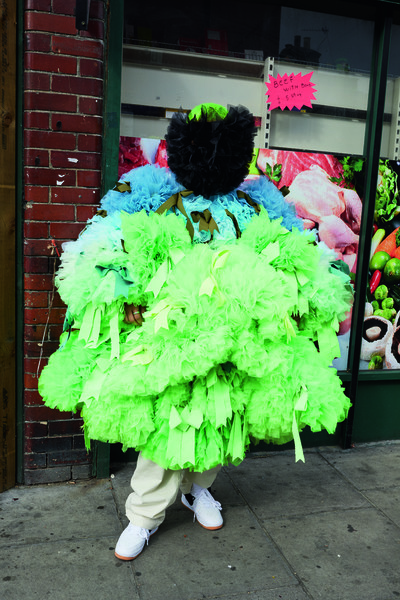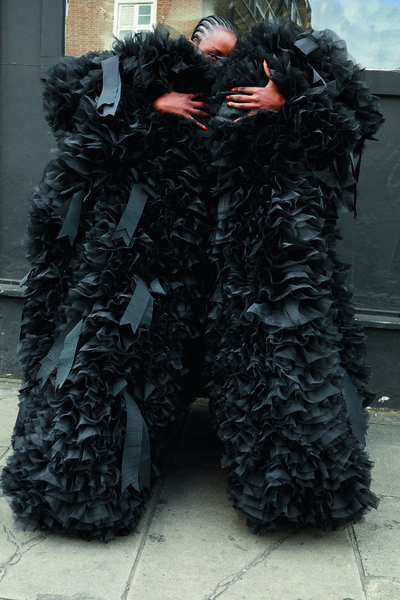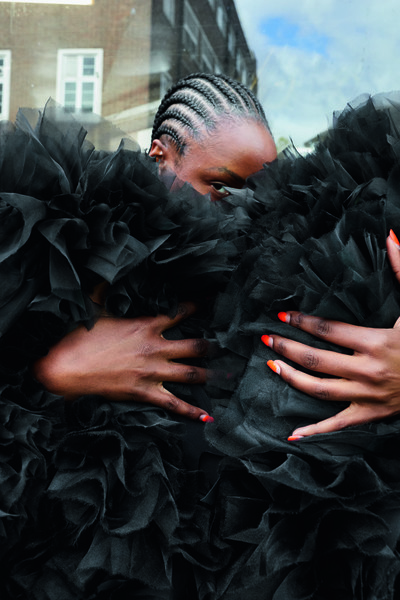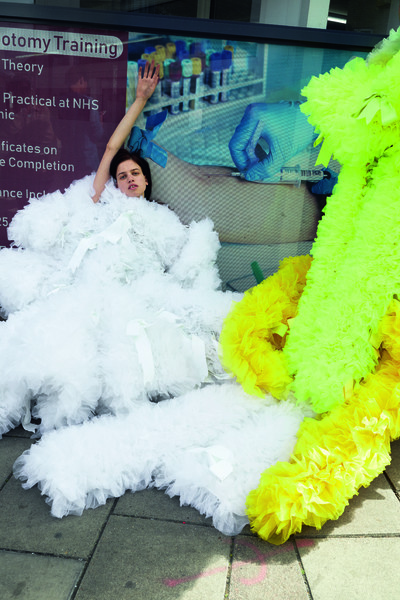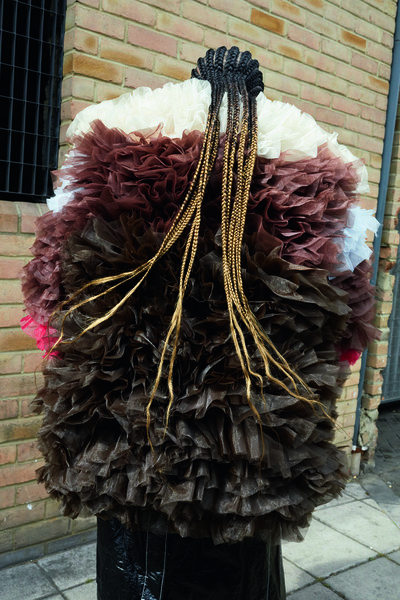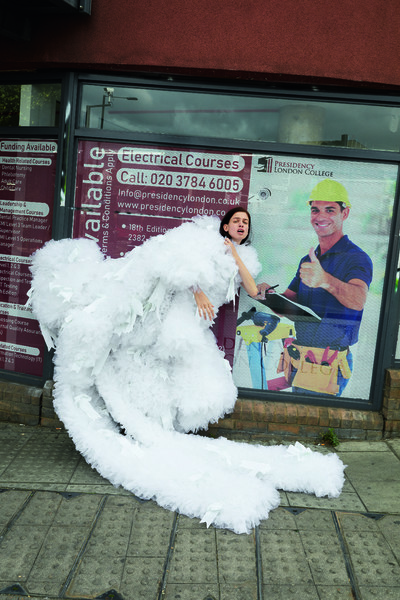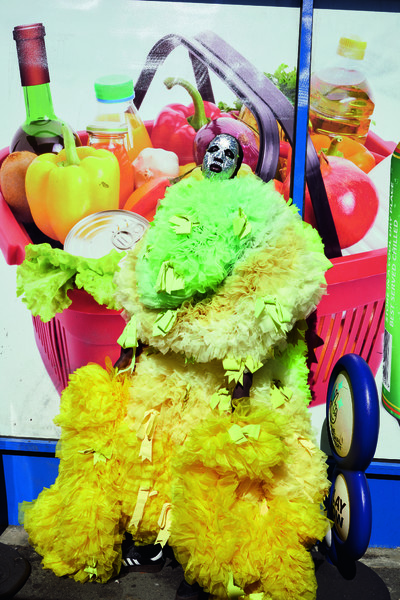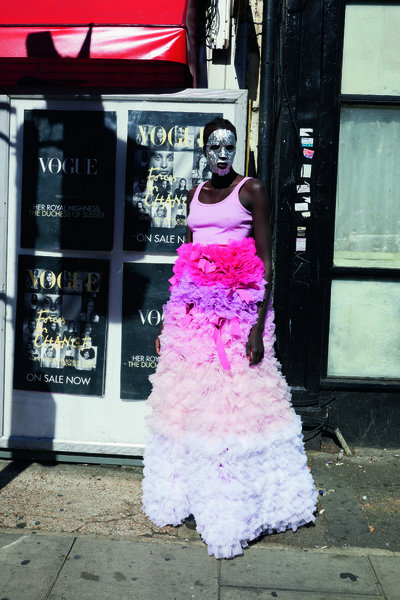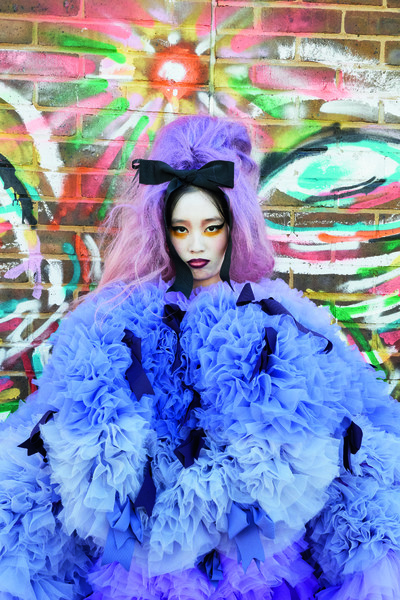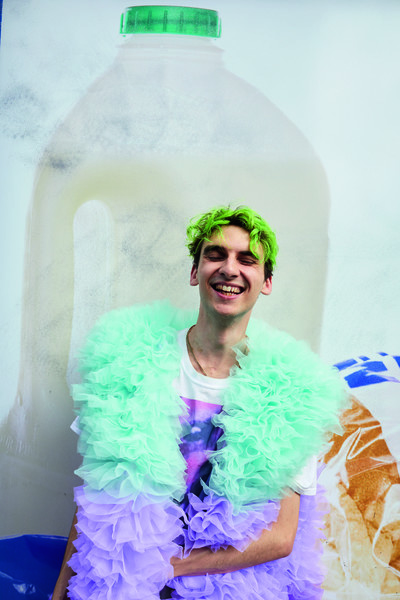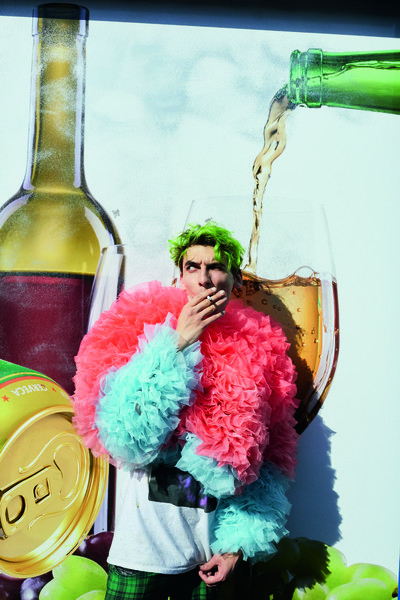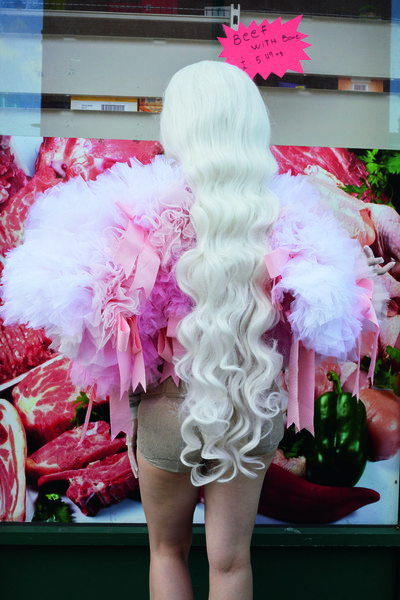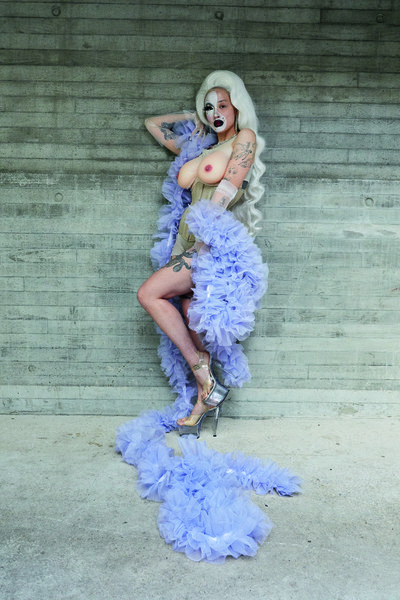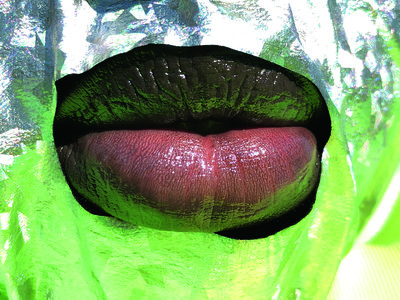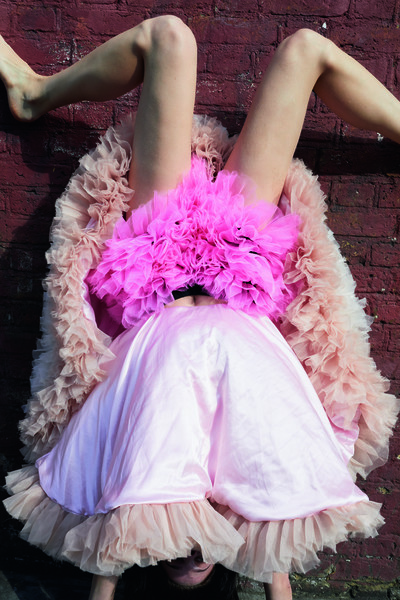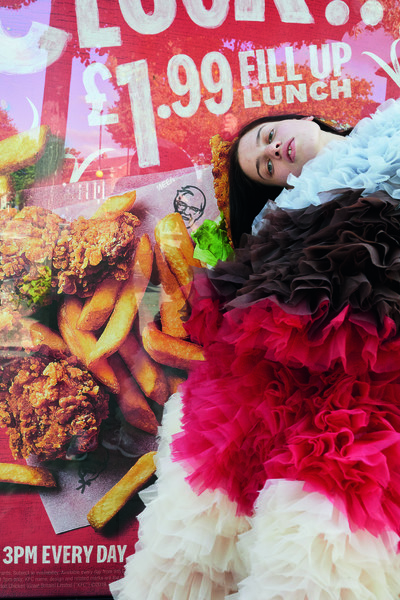Japanese costume designer Tomo Koizumi’s ‘brightly coloured fluffy creations’ have left fashion all in a daze.
By Hans Ulrich Obrist
Photographs by Juergen Teller
Styling by Vanessa Reid
Japanese costume designer Tomo Koizumi’s ‘brightly coloured fluffy creations’ have left fashion all in a daze.

At New York Fashion Week in February 2019, Tomo Koizumi’s surprise show became the fillip the industry seemed to need. Organized with a little help from Katie Grand, Gwendoline Christie, Pat McGrath and Guido Palau, and staged in Marc Jacobs’ Madison Avenue store, the Japanese designer’s ruffled collection of dresses was a perfect flurry of colour, good humour and sheer exuberance. In the months that have followed, the clothes have been spotted all over social and traditional media – from Instagram to the glossies – and after being worn on the Met Gala red carpet, have been transformed from costumes to real-life fashion. And Koizumi, a costume designer by trade, had become an overnight fashion star. In July, System asked Hans Ulrich Obrist to catch up with the designer and see how he was dealing with all this new-found attention. The ensuing conversation was a real-time study of a man feeling his way forward, slowly working out just where his next steps would take him. The first, however, was to Juergen Teller’s neighbourhood, where the photographer shot Koizumi, Obrist and some friends wearing the dresses. The results resemble Koizumi’s work: kaleidoscopic, joyous and an awful lot of fun. But before anything else, a word from one of the people at the heart of the Tomo phenomenon, Katie Grand, the editor in chief of LOVE: ‘Tomo is one of those special people who accidentally come into your life and then firmly plants their feet there. As it’s now widely known, I was introduced to Tomo’s creations by Giles Deacon via Instagram, and then shortly afterwards, I persuaded Marc Jacobs to host a show in his uptown store. Marc never doubted Tomo’s brilliance and loved his brightly coloured fluffy creations from the moment he saw them, too. Once at the studio, Tomo and his work became a usual sight on the ninth floor – the Marc showroom is black and Tomo’s pieces are usually bright. His cheery charm and innocent humility was infectious – even though his clothes take up quite a lot of space. It’s funny how the pieces arrive packed down into boxes and he and his team spend days rigorously “fluffing” the fabric with wire gloves to get the volume. I adore working and collaborating with him; he’s an absolute joy. It was also super special to bring in Ariel Nicholson this latest season to be the sole muse of the collection. And as ever it was a pleasure to spend time and be so spoiled working with Pat McGrath and Guido Palau at the beginning of the season to create such special looks.’
Hans Ulrich Obrist: It feels like you suddenly appeared! How did you come to fashion or did fashion come to you?
Tomo Koizumi: I work as a costume designer in Tokyo, making stage costumes for Japanese or Asian singers, as well as for advertising. So I see myself as half in the fashion industry and half in the entertainment industry. That is why I make these kinds of big, loud, colourful, eye-catching costumes. I first decided to be a designer in 2004; I was 14 and found a picture of Galliano’s work for Dior. Suddenly, fashion could mean bigger, extra-special things, and that is what I have always made since.
What did that image trigger in your 14-year-old mind?
Before I found that picture, I already liked to wear stylish clothes, but it was just my own personal thing. After that picture, it suddenly stopped being like normal life. I was a sad teenager and that felt like comfort and encouragement.
Did it feel like it opened up the possibility of a new world?
Yes. I lived in a closed community in the countryside; I didn’t even have access to the Internet, so I couldn’t meet anyone new easily. I only had a few friends at that time and then when I was 14, I also
realized that I was gay. It all happened at the same time: I found out I was gay and I found that Galliano picture. Two really big things happened to me at the same time, the same moment. After that, I started going to clubs, when I was 15 or so, and met some new and really different friends, from the gay community. It was really interesting and it influenced me a lot. In the club, there were so many drag queens; it was so different to normal life – I could escape from daily life.
Who are your other heroes or heroines in fashion?
Galliano at Dior is my favourite, and the brand is still my favourite. I still think it’s great. I’ve always dreamed about haute couture and fantasy. Of course, like lots of European designers and fashion students, I really like Japanese designers like Yohji [Yamamoto], but I’ve always been particularly obsessed with the British-educated designers.
‘I make stage costumes for Japanese or Asian singers. I see myself as half in the fashion industry and half in the entertainment industry.’
I was told you are inspired by Leigh Bowery.
Of course! I found pictures of him in a magazine a year or two after that Galliano picture. It was all connected because Galliano was obviously heavily inspired by Leigh Bowery. I loved the movie called Party Monster. I think I saw that when I was about 16 or 17. That kind of inspiration influenced me a lot.
And art? Your designs are really sculptural, so I wondering if you have been inspired as much by art as by fashion?
I actually majored in art when I was at university. My fashion technique is all self-taught; I didn’t study fashion at all. At university, I did everything: painting, graphic design, sculpture, and art education. I’m actually qualified as a teacher, but I don’t want to be one! I wouldn’t say I have that much knowledge about art, but I do like to go to museums. I like to use inspiration from artworks, in particular, the colours in paintings.
Which paintings?
Mark Rothko is really good to take colours from, as is Georgia O’Keeffe. I really like blended colours and different shades, and those two have blended colours. That’s why I really like O’Keeffe.
Did you go to university in Tokyo?
No, in Chiba, which is next to Tokyo, the next-door prefecture, but still the countryside. I could go to Tokyo any time I wanted, but my hometown is still surrounded by rice fields and rivers.
We often think of fashion as being an urban affair. How did the countryside inspire you and your fashion?
I have these images of nature in my memory and there were so many colours in the sea and forests around my home that I still love. I also had traditional Japanese things around me, like Japanese dolls. Also, [manga] cartoons influenced me a lot. Like Sailor Moon – that I really loved, and it really inspired
me. Growing up in the countryside made me more desperate to be known and do something big. I didn’t know about actual fashion until I discovered those Galliano pictures and suddenly thought, ‘Everything in fashion must be like that’! I actually dreamed of being an assistant to Galliano; it was one of my biggest dreams at that time. I would hunt down articles about him in fashion magazines that I used to buy.
You thought that because it was the first thing you saw?
Yes, that is why I have been following this stream until now. Also, I really want to follow that fantasy into the future because it was a really big shock to me and it changed my life.
I’ve heard that Miko girls were also important to your work and inspiration.
Traditionally, the Miko were young women who were like shamans; they were sort of not-human. They were mystical and did many things, like telling the future and dealing with funerals in shrines, so normal people both needed them and discriminated against them. There was a double standard. I started researching Miko because my family works as undertakers and in Japan, people working with the dead are a little bit discriminated against because death is kind of dirty and taboo. People don’t want to be in touch with death. That gave me a first connection with the Miko. Then their costumes are really beautiful and really Japanese: religious outfits with unique details. I’ve been inspired by certain details in Japanese funeral ceremonies, which feature lots of flowers and take place in temples. When I was really young, like four or five, I would go to temples and see these funeral ceremonies, so it all feels really natural to me.
How did you first become a costume designer? Was it your first step as a professional? It would be really interesting to hear about the costume designs that preceded your first collection.
I began designing costumes because there is not much call for big gowns for galas in Tokyo; there is not that culture. But I still really wanted to make big gowns, so that is why I found a way to work in the entertainment industry. I started working as a costume designer over seven years ago, when I was 23 or so, when I was still at university. It was for a Japanese singer called Miliyah Kato who had a sort of Harajuku style, a really famous Japanese singer who wanted to be Harajuku cute.
Were these commercial jobs?
Yes, all commercial jobs. This was one with a group in a Harajuku-style café called Kawaii Monster Café in Tokyo and they were pretending to be working there, serving dishes dressed in these ruffle costumes. It was crazy. This was in 2016. Lady Gaga wore a dress of mine when she was in Tokyo that year – that was a big moment for me. I began doing the ruffle dresses four years ago.
‘I was about 14 when I found a picture of Galliano’s work for Dior. It was a really big shock to me and it changed my life forever.’
Tell us about the technique. What fabric do you use?
It started when I found this Japanese polyester organza fabric in a market. It’s cheap, but really good quality, and it comes in 170 different colours, so I immediately wanted to do something with it. I felt I could create something really gorgeous with it and I loved all the possibilities of those colours. I tried a lot of techniques – and I failed many times. Then I found this ruffle technique about three years ago.
It is like an organza extravaganza!
Yes, yes!
What is your favourite colour?
With this technique, I like lighter colours. Pastels work better than dark colours, so I use soft colour shades with neon colours, which works so well. Sometimes I use some darker colours around the waist because it makes it look a little tighter; that’s a costume-design technique.
This extravaganza was originally designed for a singer?
Yes, a Japanese singer called Yuki; she is really famous for being really fashionable in Japan. I was so honoured to work with her.
You had collections before New York, but you didn’t show them?
Yes, it was all one-off pieces that I made to show stylists – or the world! – what I could do. I had made these costume samples and then Lady Gaga wore one look.
Has Björk ever worn your clothes?
Not yet, but Björk is my biggest muse, so I really want to dress her.
She is my friend, so we can make the connection. I will send her a message tonight. Do other people besides performers wear your clothes? Have you dressed men?
I don’t do menswear, but boys look really cute in my dresses. Actually anyone can fit into my clothes. And anyone can look cute in my dresses.
I hear that you don’t delegate the making at all, that you do a lot of the sewing yourself.
Yes, yes, so much. When I really focus a lot, I can sew for maybe five hours without stopping. As I’ve mainly been a costume designer, I’m really used to tight deadlines and not having much time to deliver. That’s why I’ve always done everything by myself or maybe with just one assistant. Also, I only do what I can do; I make the amount I can make. I have to handle everything almost by myself and my studio is really tiny.
Really, for all these big dresses?
Yes, and there are many big tables and sewing machines. I did a Met Gala dress two weeks ago which was really big – my studio was filled up with that dress.
How did that that Met Gala dress happen? It was like a creature!
Right after the show I did in February, Nichapat Suphap, who works for Vogue Thailand and is Thai, emailed me and we met in New York. She asked me to make a Met Gala dress for her, which was one of my biggest dreams, so I was really happy. Plus, she is a client so she can pay for the dress, so I was even happier!
You are featured in the exhibition Camp: Notes on Fashion, which was also the theme of this year’s Met Gala. What is camp for you?
I have never considered my design to be particularly camp, but people often find something camp-y in what I do. If I express myself and create something, it has to be different to other designs and it has to be joyous; it has to be fun. So perhaps my designs really are camp. I really loved the exhibition, though, because every piece was really different, but really fun. I was smiling looking at every design.
Giles Deacon and Katie Grand were instrumental in changing the course of your trajectory. You had a small Instagram following, but then all of a sudden you were doing a show in New York and then making a dress for the Met Ball. How did that happen? How did Giles Deacon end up putting you on his Instagram? How did it all begin?
In the middle of last year I had finished a big project in Japan, and was feeling that I wanted to do something different; something more exciting, so I tried to… I don’t how to say it… to push myself
out to the world. Last September I got the chance to create a presentation for a journalist called Sara Maino, who is at Vogue Italia. She posted my work on her Instagram and then it was reposted and
then reposted, and then Giles Deacon started following me. I think he showed my work to Katie Grand and then Love magazine contacted me to borrow some dresses for a shoot. Shipping them to London made me so happy. That was all around the end of last year. Then I posted a picture on my Instagram, this was actually with the actress Gwendoline Christie, who was in my show, the last look. Then Giles Deacon re-posted this picture on his Instagram, and in doing so introduced my works to his followers. Then Katie Grand texted me. That DM is still my screen saver! It was like 3am in Tokyo and I was so surprised. I immediately texted her back to say, ‘Thank you so much, I can bring some more new designs for your shoot.’ In that 15 minutes of chatting, we decided to do a show.
‘I don’t do menswear, but boys look really cute in my dresses. Actually anyone can fit into my clothes. And anyone can look cute in my dresses.’
So Katie began to organize the show, Marc Jacobs offered to host it in the store on Spring Street during New York Fashion Week, Guido Palau offered to do the hair, Pat McGrath the make-up, Jin Soon Choi the nails, and Katie put together a dream cast of models: Bella Hadid, Emily Ratajkowski, Karen Elson, Gwendoline Christie and Joan Smalls. Can you tell me about the whole saga of that first show?
Everything was directed by Katie Grand; I just turned up with my clothes. I met her for the first time in New York in Marc Jacobs’ studio. I was really nervous because New York is not my favourite city. I had only visited once before that show; I didn’t have friends there. So I was kind of desperate to find people I could ask for help there. Then a friend introduced me to some people at Parsons School, so I could get some help. After meeting Katie, I was relaxed, I could just focus on my own thing. The support I got from Marc Jacobs’ team was amazing. Everyone in the show was so professional; I didn’t have any problems and I was able to just enjoy it. After the show I was really tired and I thought I would have time to just relax and do some sightseeing in New York, but things got really crazy busy; everything was a rush. I mean, I didn’t have the pricing for the clothes or anything. I honestly wasn’t thinking about retail. I just didn’t know what was going to come afterwards.
Where are you going to take your technique? Your style has been getting more complex, more colourful and sculptural, so how is it going to evolve? Are you already working on the next collection?
I will start on a new collection when I get back to Tokyo; I already have an idea, which will be more presentation and less fashion show. I still don’t really have anything to sell, which I am happy about because I don’t need that much money to keep my team. I do have some new clients in the real world, but I want to do everything slowly; I really don’t like being stressed. In the fashion industry everything is really quick, but I still want to show something new and something different to the world. I will do a presentation for next season, but it will not be for sale. I really want to maximize my own brand. I think I can do that now. I’m also thinking about perfume because while not everyone can wear my bigger gowns, people still want something from my brand, so maybe they can wear perfume. That could be a good way to connect people to my brand.
How would you define fashion now?
To me, fashion and the fashion industry are two different things. I always thought that fashion shows were filled with lots of show pieces that weren’t made to be sold; that’s what I thought fashion was about. But there aren’t many of those kinds of pieces any more in fashion shows, which I find very sad. Everything is really commercial now; of course, they have to sell pieces, but they should also be delivering or serving up a fashion fantasy to the world.
Instagram was key to you being discovered and you use it to post your work and inspirations. What does the app mean to you and what is the Internet’s role for you as a fashion designer?
The things that have happened to me prove that with the Internet and Instagram, you can make something unique or special and then get yourself out there in the world; it means people can find
you and then perhaps take you to the right place. My story is like a lesson to younger generations or younger designers that even if you live in the middle of nowhere – not in London, Paris or New York – you can get yourself known. If my story can give some hope to young designers, then I am so happy.
‘After the first show I was tired and I thought I’d have time to just relax and do some sightseeing in New York, but things got really crazy busy.’
What was your most recent dress?
My most recent dress was for a client in Tokyo last week. It was in ruffles in different materials, and it was metallic. It was a bit different to other dresses.
Do you have any unrealized projects or dreams?
My dream project would be to have my own exhibition in a museum. The Metropolitan was one of my biggest dreams, so I already got that with Camp, and the Met Gala is big for all fashion designers – and I am not that big a designer.
You have said you would like to do a capsule collection of ready-to-wear. Where are you with that?
I was talking with many buyers about making a capsule collection or ready-to-wear, but during the conversations I discovered that I am not ready yet. I could produce something for sale if I wanted to, but I don’t feel like this yet and selling things is really difficult. Also, I want to do things differently to other younger designers, other designers; that is why I don’t do this now. I still want to contact and connect with buyers, and I want to show something to them, so that in few seasons’ time I could still work with them. I am talking to them, but I haven’t worked out anything yet.
Do you feel part of a fashion design group in Japan? Do you have friends in fashion?
I don’t have any designer friends in Japan, maybe more in Europe. I don’t know why; perhaps because I didn’t go to fashion school, so I have always hung out more with make-up artists and gay
friends. I don’t know many people in the fashion industry in Japan. I only know stylists who I’ve worked with. Things have changed in these past few months, but I am still independent.
Are you interested in the history of fashion? The clothes you presented at the New York show made me feel like you knew about the history of fashion.
For the last collection I used some silhouettes from Dior and Balenciaga; I don’t know if people saw that or not. I really wanted to do something new that was also historical. About fashion history, I don’t think that my ruffle technique is that new and my way of using colours is not unique to me. The ruffle technique, for example, was used by Hussein Chalayan and Jean Paul Gaultier, maybe even Jean Patou. I really love his designs. I am not sure I did anything new, but if people say that my designs are really new or joyous and fun, that is always nice to hear. I really admire British-educated designers like Galliano, like Alexander McQueen, Christopher Kane, Marios Schwab; they all come from Central Saint Martins and so London was the first foreign city I visited.
Do you think it is important for a designer to get a job at a big fashion house, like Galliano and McQueen did?
Of course. Working for a big house means being able to see their archives or look at their history, and that is really interesting for a designer. It must be really difficult, but I would love to try it if I can.
When you think about you own brand, do you have a clear idea in terms of business and financially of what you want it to look like?
Until now, I have always felt like I really want to keep my team small because a bigger team means bigger costs, so I would have to do things that I wouldn’t want to do to earn money. At the moment I am happy to make only one piece as a sample that can go out into the world on Instagram. Then clients can order one if they like it. I don’t really have anything to sell like other brands.
Japan and Japanese fashion have this incredible way of looking at things that exist in cultures, in Western or European cultures and remixing them. Do you feel you do that?
I think Japanese brands or Japanese designers are really good at that mix and match of cultures and elements to make wearable designs. That’s what Undercover does and I really love their designs. Since the beginning I have really wanted to do something different from international designers. It was almost too big to think about, but I have always tried to do things differently. That thought maybe makes my design different to other Japanese designers.
Not really selling anything is quite subversive today when so much is governed by commercial ambition. I suppose working as a costume designer gives you the space to think about your own designs that may have a commercial future, but at your own pace. What do you love about costume design?
I love it because I get to meet the client face to face, and because you are making clothes that will be worn on stage. Watching singers with real attitude wear my clothes on stage is just really fun – and it makes me really happy.
Creative partner to Juergen Teller: Dovile Drizyte.
Models: Charlie Fox, Jeongmo Ku, Lily McMenamy, Jenn Nkiru, Niko Riam, Victoria Sin, Ying.
Hair stylist: Syd Hayes.
Make-up artist: Miranda Joyce.
Executive producer: Emanuele Mascioni.
Producer: Samira Andersson.
Photography assistant: Karin Xiao.
Post Production: Catalin Plesa @ Quickfix Retouch.
Styling assistant: James Chester.
Hair assistant: Paula McCash.
Make-up assistant: Phoebe Taylor.
Production assistants: Tommaso Albertini, Annabel Snoxall.
